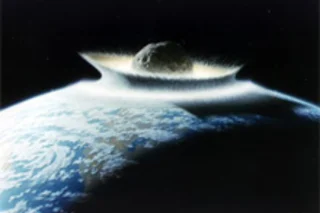Imagine an asteroid, hurtling toward the Earth. A really big one, a kilometer across, weighing millions of tons. In fact, don't even imagine, watch this video for a simulation. Bad news, right? What to do? If time is really short, we may need to fire up the nuclear weapons in a desperate bid to either destroy the asteroid or alter its direction, but emphasis on the word desperate. It's a long shot that it will help at all.
But hopefully we'll have some more time than that, maybe on the order of 40 or 50 years. Then we can make plans. In How I saved the World, Valentin Ivanov's short story from Diamonds in the Sky, a heroic team of astronauts are living on the surface of an asteroid called "The Hammer" and...painting it black.
OK, here's the theory: A rotating object in space will absorb heat and light from ...



